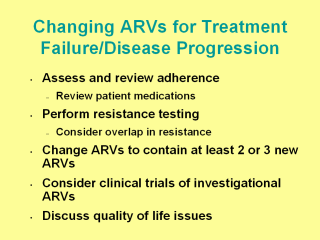| front |1 |2 |3 |4 |5 |6 |7 |8 |9 |10 |11 |12 |13 |14 |15 |16 |17 |18 |19 |20 |21 |22 |23 |24 |25 |26 |27 |28 |review |
 |
Although the efficacy of different combination
ARVs in children probably can be extrapolated from clinical trial data
obtained for adults, data are limited regarding the pharmacokinetics,
appropriate dosing, and short- and long-term safety of various combinations
in children. The choice of a new ARV regimen is dictated by the indications that warranted the change in therapy (e.g. toxicity/intolerance vs. drug resistance vs. poor adherence) and the available alternative ARV agents. A decision to change therapy and the proposed new regimen to be chosen should partly take into account the impact of the changes on future treatment options. When changing therapy because of treatment failure, assess adherence to therapy as a potential cause of failure. If the patient is adherent to the prescribed drug regimen, assume the development of drug resistance and, if possible, change to at least two new ARVs. Change in one drug or addition of a drug to a failing regimen is suboptimal. The new regimen should include at least three drugs, if possible. Consider the potential for cross-resistance between ARVs when choosing new drugs. A change to a new regimen, especially one containing PIs or NNRTIs, must include a discussion of treatment adherence issues by the healthcare provider with the patient, when appropriate, and caregivers of the infected child. Recognize that certain medications are difficult to take in combination because of exacting and often conflicting requirements e.g. with/without food and other ARVs. Palatability, pill size, number and dosing frequency are part of the considerations when choosing the new regimen and should be discussed with the child, and when appropriate, with the childís caregivers. When considering changing therapy because of disease progression in a patient with advanced disease, consider the patientís quality of life. |